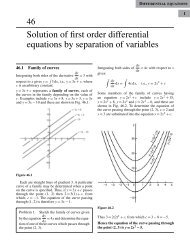trigonometry
You also want an ePaper? Increase the reach of your titles
YUMPU automatically turns print PDFs into web optimized ePapers that Google loves.
118 GEOMETRY AND TRIGONOMETRY<br />
Figure 12.7<br />
3. For the right-angled triangle shown in<br />
Fig. 12.8, find:<br />
(a) sin α (b) cos θ (c) tan θ<br />
[<br />
(a) 15<br />
17<br />
(b) 15<br />
17<br />
(c) 8 ]<br />
15<br />
tan 38 ◦ = PQ<br />
QR = PQ<br />
7.5<br />
hence PQ = 7.5 tan 38 ◦ = 7.5(0.7813)<br />
= 5.860 cm<br />
cos 38 ◦ = QR<br />
PR = 7.5<br />
PR<br />
hence PR = 7.5<br />
cos 38 ◦ = 7.5 = 9.518 cm<br />
0.7880<br />
[Check: Using Pythagoras’ theorem<br />
(7.5) 2 + (5.860) 2 = 90.59 = (9.518) 2 ]<br />
Problem 7.<br />
Fig. 12.10.<br />
Solve the triangle ABC shown in<br />
Figure 12.8<br />
4. Point P lies at co-ordinate (−3, 1) and point<br />
Q at (5, −4). Determine<br />
(a) the distance PQ<br />
(b) the gradient of the straight line PQ and<br />
(c) the angle PQ makes with the horizontal<br />
[(a) 9.434 (b) −0.625 (c) 32 ◦ ]<br />
12.4 Solution of right-angled triangles<br />
To ‘solve a right-angled triangle’ means ‘to find the<br />
unknown sides and angles’. This is achieved by using<br />
(i) the theorem of Pythagoras, and/or (ii) trigonometric<br />
ratios. This is demonstrated in the following<br />
problems.<br />
Problem 6. In triangle PQR shown in Fig. 12.9,<br />
find the lengths of PQ and PR.<br />
Figure 12.9<br />
Figure 12.10<br />
To ‘solve triangle ABC’ means ‘to find the length<br />
AC and angles B and C’<br />
sin C = 35<br />
37 = 0.94595<br />
hence ∠C = sin −1 0.94595 = 71.08 ◦ = 71 ◦ 5 ′ .<br />
∠B = 180 ◦ − 90 ◦ − 71 ◦ 5 ′ = 18 ◦ 55 ′ (since angles in<br />
a triangle add up to 180 ◦ )<br />
sin B = AC<br />
37<br />
hence AC = 37 sin 18 ◦ 55 ′ = 37(0.3242)<br />
= 12.0 mm<br />
or, using Pythagoras’ theorem, 37 2 = 35 2 + AC 2 ,<br />
from which, AC = √ (37 2 − 35 2 ) = 12.0 mm.<br />
Problem 8. Solve triangle XYZ given<br />
∠X = 90 ◦ , ∠Y = 23 ◦ 17 ′ and YZ = 20.0 mm.<br />
Determine also its area.<br />
It is always advisable to make a reasonably accurate<br />
sketch so as to visualize the expected magnitudes of<br />
unknown sides and angles. Such a sketch is shown<br />
in Fig. 12.11.<br />
∠Z = 180 ◦ − 90 ◦ − 23 ◦ 17 ′ = 66 ◦ 43 ′<br />
sin 23 ◦ 17 ′ = XZ<br />
20.0










